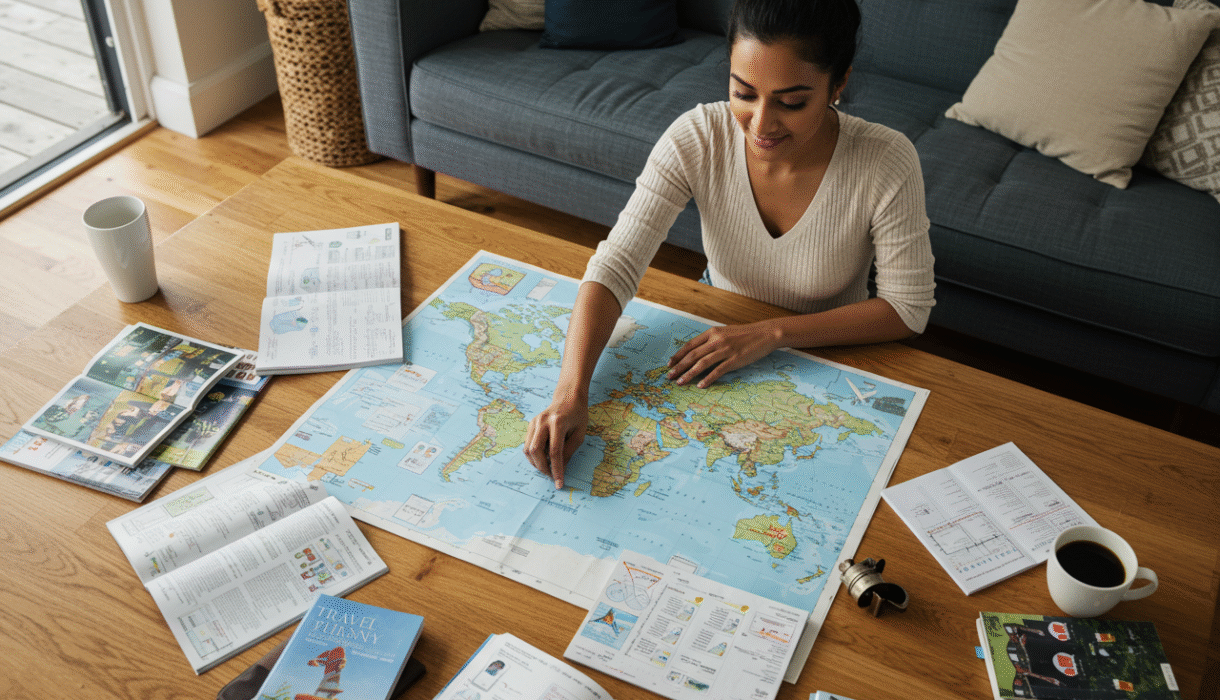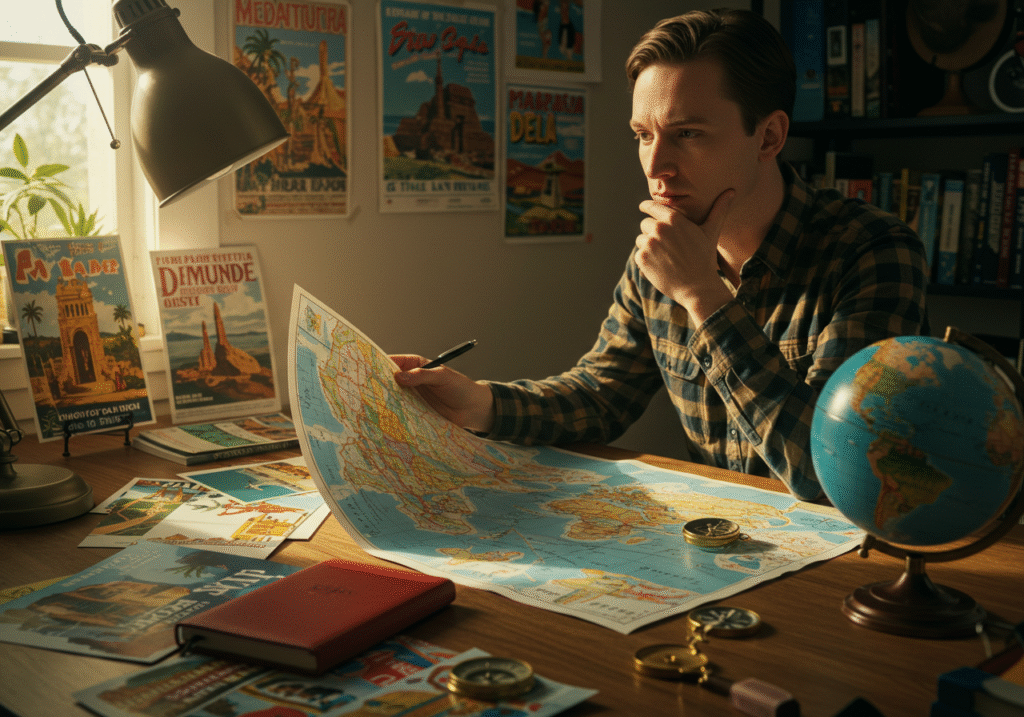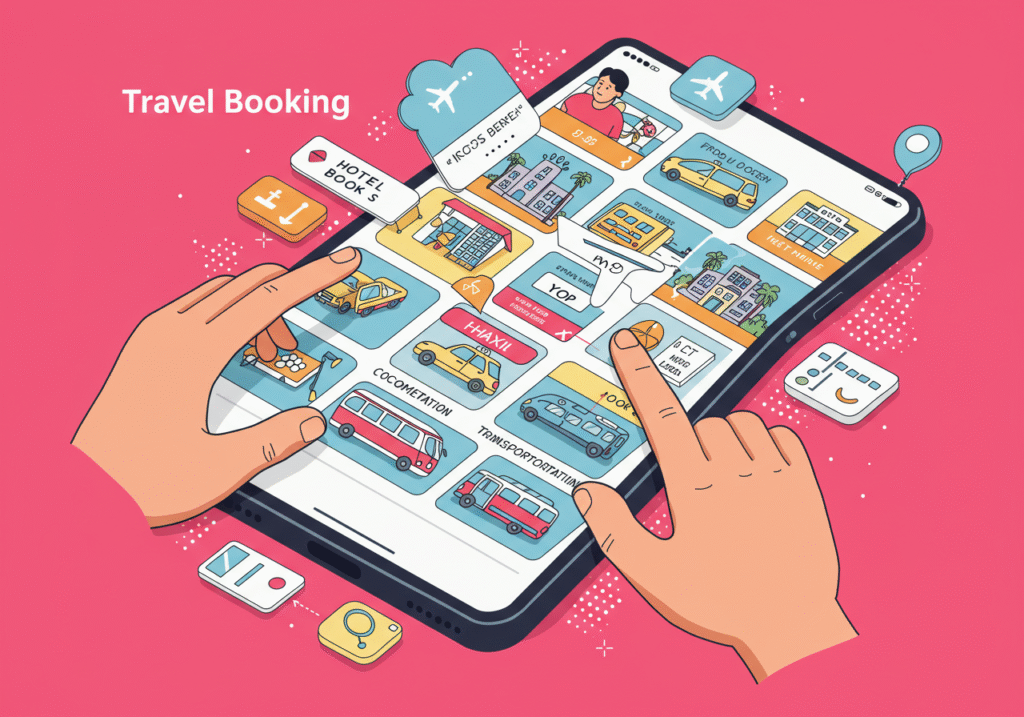
Your Stress-Free Travel Blueprint: Easy Steps to Plan a Great Trip
Posted in :
What Are You Really Looking for in Your Trip? Find Your True Travel Purpose
Before diving into planning mode, take a step back and ask yourself: What do I truly want from this trip? Pinpointing your travel goals from the outset helps shape a journey that resonates with your needs, values, and personal interests. Whether you’re craving high-energy adventure, quiet relaxation, cultural discovery, or meaningful time with loved ones, defining your purpose adds clarity to every step of your planning process.
Start by reflecting on the kind of experiences that spark excitement for you. Are you drawn to action-packed activities like hiking rugged trails, diving into oceans, or skiing snowy peaks? Or do you dream of quiet mornings in a countryside inn or sun-soaked afternoons on the beach? Perhaps your heart lies in history, food, and art—exploring new cultures and traditions in places rich with local life.
Are you going solo, with a partner, or as a family? The nature of your company will naturally influence your plans. A family trip might call for child-friendly attractions and balanced downtime, while a solo or friends’ trip could lean toward social experiences or spontaneous exploration.
When you align your intentions with the style of your travel, everything starts to fall into place. Knowing whether you’re chasing rest, excitement, connection, or discovery makes it easier to design a trip that delivers exactly what you need. In the end, a well-thought-out goal doesn’t just guide your itinerary—it transforms your journey into something meaningful and unforgettable.

Budgeting for Your Trip
Budgeting is a fundamental element of effective trip planning, as it provides a clear financial framework within which travelers can operate. To determine your overall trip budget, begin by assessing your financial situation and setting a clear limit on how much you can afford to spend. This budget should encompass all anticipated expenses including transportation, accommodation, food, entertainment, and activities.
Transportation often comprises a significant chunk of the trip budget. To save costs on flights or car rentals, consider booking in advance, using flexible dates, and exploring various travel agencies for deals. Fares may vary, so utilizing fare comparison websites can yield substantial savings. Additionally, local transportation alternatives, such as public transit, can help keep expenses in check.
Accommodation choices can also fluctuate greatly in price. Determine your lodging preferences, and assess options ranging from hotels and hostels to vacation rentals or even camping. Staying outside of major tourist areas may provide lower rates and unique local experiences. Websites dedicated to finding discounts or last-minute deals can be beneficial in this regard.
Food is another area where travelers can manage their budget effectively. Opt for local dining establishments over tourist traps, and consider self-catering options if your accommodation allows. This not only saves money but also offers a chance to explore local markets and cuisine. Entertainment and activities should be prioritized based on personal interests and the experiences that can enhance your trip. Many destinations offer free or low-cost attractions, so research these before finalizing plans.
To maximize your trip experience while adhering to financial constraints, it can be productive to create a detailed itinerary including estimated costs. This practice allows for the identification of areas where adjustments may be necessary, ensuring that the trip remains enjoyable and within budget. By being mindful of spending and seeking out deals, you can enjoy a fulfilling journey without exceeding your financial limits.

Where to Go and Why: Crafting a Journey That Fits You
Once travelers have established their goals and budget, the next critical step involves selecting the right destinations that resonate with their aspirations. This process starts with extensive research on potential locations. Factors such as climate, cultural experiences, accessibility, and local attractions should guide your decision-making. Begin by identifying regions that match your interests—whether it be historical sites, nature, or vibrant city life. Utilizing travel blogs, forums, and social media platforms can provide insights and personal experiences that can prove invaluable in narrowing down your options.
When selecting a destination, it is essential to consider traveling during off-peak seasons. This approach not only often results in lower costs but also allows for a more authentic experience, as popular tourist spots are less crowded. For instance, visiting European cities in the late spring or early fall can provide a more intimate and enjoyable experience.
After determining your destinations, the next step is to create a balanced itinerary. A well-structured itinerary should encompass both planned activities and leisure time for spontaneous exploration. Allocating specific days for key attractions ensures that tourists do not miss out on must-see spots, while also preserving flexibility to engage with unexpected opportunities that arise. A practical way to achieve this is by grouping activities by location; this minimizes travel time and enhances efficiency.
Additionally, consider incorporating downtime into your schedule. This provides a chance to recharge and absorb the local ambiance without feeling rushed. Remember, travel is not just about ticking off a checklist but also about immersing oneself in the environment. By thoughtfully selecting destinations and carefully crafting your itinerary, you will set the stage for a fulfilling travel experience that aligns with your objectives and enhances your overall journey.

Where You’ll Stay and How You’ll Get There: Smart Travel Planning Made Easy
Once your destinations are set, the next critical steps involve booking suitable accommodations and arranging transportation. These two elements can significantly influence the overall experience of your trip, so careful consideration is essential. When evaluating accommodations, several factors must be taken into account, including the property’s location, available amenities, and price. The location is paramount, as it determines your proximity to attractions and accessibility to local transportation. Opt for accommodations situated in safe neighborhoods with convenient access to public transport or major highways, depending on your travel preferences.
When it comes to amenities, consider what will enhance your stay. Free Wi-Fi, complimentary breakfast, and on-site parking are often attractive features that can elevate your experience without significantly affecting your budget. Utilizing various booking platforms can help you compare prices and uncover exclusive deals. It is advisable to read reviews and check ratings from previous guests to gauge the quality of accommodations accurately. This due diligence can contribute to a more satisfactory lodging choice.
Transportation options should also be carefully evaluated. Whether you choose to fly, take a train, or rent a car depends on the nature of your journey and the convenience each option offers. If flying is your preference, booking flights well in advance typically results in lower fares. For train travel, exploring different routes and preferences can reveal options that may enhance your travel experience. If opting for a car rental, understand the local driving laws and compare rental prices from multiple agencies to find the best deal. Evaluating these aspects of transportation will ensure smooth transitions throughout your trip.
In conclusion, a well-thought-out strategy for booking accommodations and transportation can dramatically impact your travel experience. By considering location, amenities, and various transportation options while seeking quality solutions at affordable prices, travelers can enjoy their journey to the fullest.

Pack Like a Pro: What You Really Need for Any Trip
Packing for a trip is more than simply filling a suitcase; it requires careful consideration of the destination, duration, and purpose of travel. To ensure a smooth and enjoyable experience, travelers should focus on distinguishing between essentials and non-essentials. Essentials include items critical for daily needs, such as appropriate clothing, toiletries, medication, and necessary electronics. When choosing clothing, it is prudent to consider the weather conditions and activities planned during the trip. For example, lightweight, moisture-wicking fabrics are ideal for warm climates, while insulated layers might be required for colder destinations.
Moreover, packing techniques can greatly affect how much can be accommodated in a limited space. Roll your clothes instead of folding them, as this method saves space and reduces wrinkles. Utilize packing cubes to organize items within your luggage, making it easier to locate what you need without unpacking everything. Additionally, prioritize packing versatile pieces that can be mixed and matched, reducing the overall volume of clothing needed. For instance, a single pair of comfortable shoes can serve well for both casual outings and formal events if styled appropriately.
Travel accessories can also enhance convenience and comfort during journeys. Consider investing in a quality travel backpack, which provides ease of movement and accessibility. A portable charger, travel-sized toiletries, and a lightweight travel blanket can contribute significantly to the overall travel experience. Noise-cancelling headphones are beneficial for long flights, while a reusable water bottle helps travelers stay hydrated without contributing to plastic waste.
In summary, strategic packing can elevate the travel experience, ensuring smart travelers are well-prepared for a variety of situations. By focusing on essentials, employing space-saving techniques, and utilizing helpful accessories, one can arrive at their destination feeling organized and relaxed.
Staying Organized and Prepared
In the realm of travel, staying organized is essential for a smooth and enjoyable experience. A well-structured plan begins with the proper management of travel documents, bookings, and itineraries. Leveraging digital tools and mobile applications can significantly enhance organization, providing travelers with access to their important information at their fingertips. It is advisable to utilize apps that consolidate flight details, accommodation reservations, and transportation schedules into a single interface. These apps can send real-time notifications related to flight changes or itinerary updates, reducing stress and enhancing the travel experience.
Additionally, adopting a systematic approach to storing electronic and paper documents can prove beneficial. Maintaining digital copies of crucial documents, such as passports, travel insurance policies, and vaccination records, in a secure cloud storage system allows for retrieval anytime, anywhere. Likewise, organizing physical documents in a travel wallet can ensure easy access during airport check-ins or hotel registrations.
As part of preparation, one should not overlook the significance of travel insurance. Insurance coverage serves as a safety net against unforeseen events such as trip cancellations, medical emergencies, or lost luggage. Evaluating various insurance policies to select one that best fits the travel itinerary and individual health needs is essential. For instance, policies that cover adventure activities may be appropriate for travelers engaging in high-risk sports.
Health preparations also play a vital role in ensuring a hassle-free trip. Researching health advisories for the destination, including recommended vaccinations and local medical facilities, allows travelers to take proactive measures. Carrying a basic first-aid kit and any personal medications can avert potential complications. By integrating these effective strategies into the travel planning process, individuals can maintain a state of preparedness that contributes to a more enjoyable and organized adventure.
Respect the Culture: What to Know Before You Go
Traveling to a new destination offers an opportunity to immerse oneself in different cultures, but it is essential to approach these experiences with respect and understanding. Familiarizing oneself with local customs and cultural nuances is crucial to enhancing the travel experience and fostering positive interactions with residents. Before embarking on a journey, travelers should conduct thorough research on the social norms and traditions of their chosen destination.
Every culture has its own unique set of customs, ranging from greetings to mealtime etiquette. For instance, in some countries, it is customary to greet others with a handshake, while in others, a bow is the norm. Understanding these differences can prevent misunderstandings and help travelers navigate social situations more gracefully. Furthermore, being aware of local traditions surrounding hospitality can lead to more authentic experiences, such as accepting invitations to share a meal or participate in community events.
As part of cultural awareness, travelers should also learn about the attire and behavioral expectations in their destination. Certain places may have dress codes, particularly when visiting sacred sites or religious ceremonies. Dressing appropriately not only shows respect but also enhances the experience by allowing for deeper connections with local communities. Additionally, engaging with residents in a respectful manner, such as using basic phrases in the local language or expressing gratitude, can go a long way in building rapport.
Overall, understanding and respecting local customs and cultural practices can transform a routine trip into a memorable adventure. By making the effort to learn about the traditions and social norms of a destination, travelers can enjoy richer cultural experiences, leading to a more fulfilling and enriching journey. In this way, the art of travel becomes not just about visiting new places, but about connecting with the people and cultures that define them.
How to Truly Enjoy and Enrich Your Travels
Traveling offers an exceptional opportunity to immerse oneself in new cultures, landscapes, and experiences. To truly make the most of your journey, it is vital to maintain flexibility in your plans. While having a clear itinerary can provide structure, allowing for spontaneity opens the door to unexpected adventures. Embracing last-minute changes or unplanned detours can lead to unique experiences that may not be found in typical tourist guides.
Engaging with the local culture is another key aspect of a fulfilling travel experience. One of the most effective ways to connect with a destination is through its cuisine. Trying local dishes not only satisfies the palate but also provides insight into the region’s history and traditions. Participating in cooking classes or food tours can offer a hands-on approach to learning about local ingredients and culinary techniques, further enriching your stay.
Additionally, seeking out cultural activities, such as traditional performances or local festivals, enhances the understanding of the destination. These activities can serve as authentic windows into the lifestyle and values of the people who inhabit the area, fostering a deeper appreciation of your surroundings.
Moreover, it is essential not to rush through your travel itinerary. Taking time to pause and reflect on your experiences can be incredibly rewarding. Consider setting aside moments each day to jot down thoughts or feelings about your journey, allowing for a more profound connection to the places you visit. By doing this, you not only catalog your memories but also deepen your appreciation for the cultural nuances and individual stories that shape the world around you.
After the Journey: Lessons and Lasting Impressions
After the excitement and adventure of traveling, it is equally important to engage in post-trip reflection to fully appreciate the experiences gained during the journey. This reflective process involves analyzing the events that transpired throughout the trip, which can provide valuable insights and enhance future travel planning. By taking the time to think critically about what worked well and what could have been improved, travelers can cultivate a deeper understanding of their preferences and preferences for future trips.
One effective method of reflection is to document the journey through journaling or photography. Maintaining a travel journal allows individuals to articulate their thoughts and feelings during the trip. It provides a space to describe memorable moments, interactions with locals, and personal discoveries. Photography, on the other hand, serves as a visual chronicle of the experiences. Capturing stunning landscapes, local cuisines, and cultural encounters can evoke emotions and transport travelers back to those moments. Together, these practices offer a comprehensive representation of the trip, enriching one’s travel experiences.
Additionally, sharing travel experiences with others can foster connections and facilitate new perspectives. Engaging with friends and family about adventures not only allows individuals to relive pleasant memories but also encourages discussions that can lead to valuable advice for future travels. Whether it’s a casual conversation or a more structured presentation, sharing these experiences cultivates relationships and inspires others to explore new destinations.
Furthermore, during this period of reflection, it is essential to consider the lessons learned from the trip. Each journey brings unique challenges and triumphs, all of which contribute to personal growth. Understanding what worked or didn’t can enhance travel planning, making subsequent trips more enjoyable and fulfilling. A thoughtful post-trip reflection can be the key to mastering the art of travel, turning each experience into a stepping stone for future adventures.

